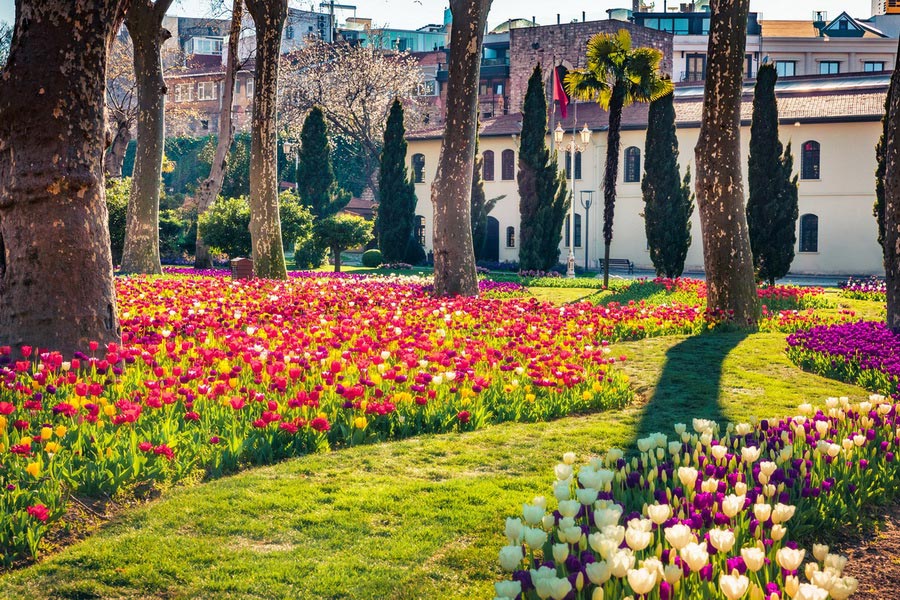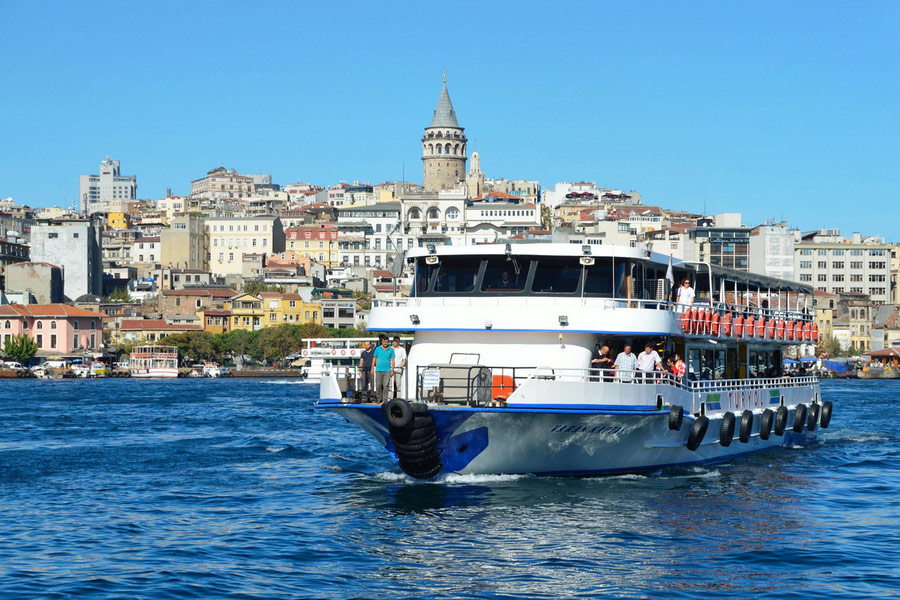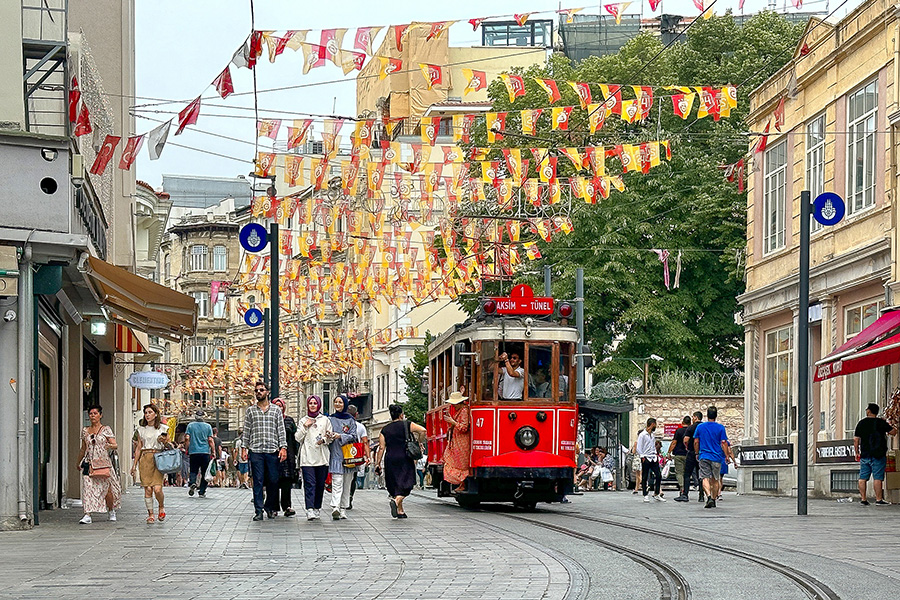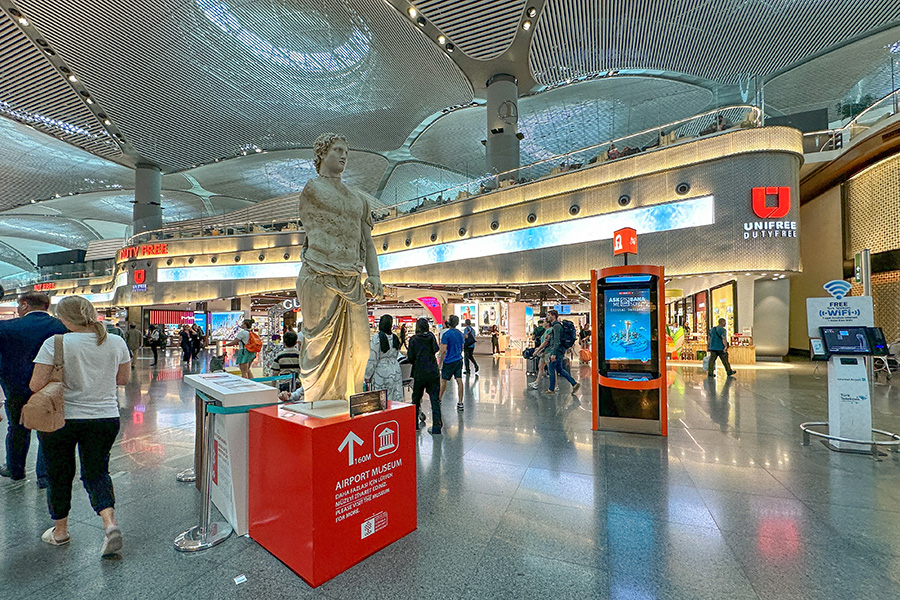Tours, Attractions, and Things To Do in Istanbul
Istanbul Travel Guide
Orhan Pamuk, the Turkish 2006 Nobel Prize in Literature, wrote in his book “Istanbul”: “After the Ottoman Empire collapsed, the world almost forgot that Istanbul existed.” As the years passed, things changed, Istanbul travel destination has emerged among the top in Turkey (Türkiye). According to Statista, it welcomed 18 million international tourists in 2024.
This biggest city in Turkey, with a population of over 15 million in the Marmara region, prides itself on its architectural beauty, ancient history, profound tradition, delicious food, and superb location. The crossroads of civilisations is what makes Istanbul tourism so charming and intriguing, even amid its fast pace, skyscrapers, and other modern structures.
The Hagia Sophia, Blue Mosque, Topkapı Palace, and Grand Bazaar are among top places to visit in Istanbul for history and architecture lovers. Once a church, then successively a mosque and a museum, now a mosque again, Hagia Sophia Grand Mosque (Ayasofya Camii) is an architectural marvel. The opulent Topkapı Palace (Topkapı Sarayı) was a center of the Ottoman Empire for centuries. A masterpiece of Islamic architecture is the Blue Mosque. At the Grand Bazaar, an adventurer can soak up the exhilarating atmosphere, haggling, Turkish sounds, and scents and admire the market’s ceilings painted in Islamic motifs and with mosaic tiles.
For those exploring this enchanting city, our comprehensive Istanbul travel guide would highlight the key things to do in Istanbul, public transport, shopping in Istanbul, Istanbul restaurant recommendations, and more.
Istanbul Tours

The best way to tour Istanbul is to explore its vibrant neighbourhoods on foot, taking in this bustling metropolis's atmosphere and discovering the Istanbul attractions. Istanbul is relatively affordable compared to other major European cities, with a wide range of accommodation and dining options to suit all budgets. If time is limited, consider a one-day tour from the airport to cover some of the top historical sites in Istanbul, including the Hagia Sophia, the Blue Mosque (Sultan Ahmed Mosque), and the Grand Bazaar.
Best Time to Visit Istanbul
The best time to visit Istanbul is April through May and September (spring or autumn). Summers are scorching, and winter cold can pierce into the bone. On the other hand, nature and Istanbul flora bloom with the onset of spring, while autumn offers a wealth of colour and a pleasant breeze, making them ideal periods for visiting many of the Istanbul tourist spots. These shoulder seasons also mark the peak of Istanbul tourism as the city enchants visitors through its refreshing weather and vibrant outdoor activities.
History of Istanbul

Istanbul, a city that used to be the capital of four empires, is compelling evidence of Turkey’s rich historical background. First founded as Byzantium in 660 BC, it was later renamed Constantinople by Roman Emperor Constantine I in 330 AD, when he made it the new capital of the Roman Empire.
During the Byzantine Empire, Constantinople prospered as a cultural and learning centre, and its Hagia Sophia cathedral was among the most splendid buildings in the world. However, in 1453, the city fell to the Ottoman Turks, who transformed it into the capital of their empire.
Under the Ottoman rule, Istanbul saw a period of tremendous growth and prosperity. The city’s population augmented, and new mosques, palaces, citadels, and other structures were built. Istanbul also became a major centre of trade and commerce, connecting Europe and Asia.
With the decline of the Ottoman Empire in the 19th century, Istanbul lost some of its former glory. Nevertheless, the city remained an important cultural and political centre.
In 1923, the new parliament abated the Ottoman Empire and proclaimed the Republic of Turkey. Mustafa Kemal Atatürk, also named Mustafa Kemal Paşa (Pasha), is the founder and the first president of Turkey. He is considered a national hero. Ankara replaced Constantinople as its capital. The current name "Istanbul" came into being on March 28, 1930. The city continued to grow and advance in the subsequent years.
Things to Do in Istanbul
Landmarks and Attractions

Istanbul is a city densely packed with things to see and do. Even travellers to Turkey for a short stay can make much of their time by following the Istanbul travel guide to tour the top historical sites in Istanbul.
Undoubtedly, it is one of the most captivating and oldest cities in the world, and no visit to Turkey is complete without wandering in its ancient sites, which are central to Istanbul tourism, and demonstrate impressive architectural styles.
The Hagia Sophia (Ayasofya Camii), originally a Christian basilica, was built in the 4th century, rebuilt during the Byzantine Empire in the 6th century AC, and converted into a mosque during the Ottoman Empire. Today, it’s a famous Turkish monument. Each year, a great number of tourists lay eyes on its massive dome, exquisite mosaics, and two grand marble cubes.
The next stop should be the Topkapı Palace (Topkapı Sarayı), just behind the Hagia Sophia. The construction of the first edifice, ordered by Sultan Mehmed II, the Conqueror, started in 1459 and wrapped up in 1856 with the completion of the Dolmabahçe Palace. The highlights of the Topkapı Palace are lavish interiors and gardens overlooking the Bosphorus Strait. Uncovering its imperial quarters, the harem, and a mint is like diving into a distant history. This pearl of Ottoman architecture, one of the UNESCO World Heritage sites, once housed over four thousand people as well as a hospital, and mosques. It’s now a fascinating museum.
Another recognisable structure not to miss out on your Istanbul travel itinerary is Sultan Ahmet Mosque. The other name, the Blue Mosque, derives from the blue Iznik tiles used to decorate the interior. The mosque is a complex of sites, including a madrasah, imaret (kitchen), hospital, primary school, market, and the tomb of the royal family.
The Roman and Eastern Roman Empires were known for spectacular entertainment like gladiator fights and a more popular – chariot racing. Istanbul's Sultanahmet Square site was the Hippodrome of Constantinople, built to accommodate chariot races and other public gatherings. Although not in its complete state, the Hippodrome arena can still stir up the imagination while walking through fascinating relics of the past.
“I’m speechless,” “amazing,” and “awe-inspiring” – that is how newcomers often describe their experience after visiting the Basilica Cisterns (Yerebatan Sarnıcı). The sounds of classical music heard in this ancient water tank, built in 532 AD, add to the mystical feel, along with the row of huge sprawling columns, a renowned Medusa head, and a hand emerging from the water.
These top places to visit in Istanbul are easy to explore on foot because they are found in the historical district of Sultanahmet.
A bit out of the way is the Süleymaniye Mosque (Süleymaniye Camii), built by the Ottoman Grand Architect Mimar Sinan for Sultan Süleyman the Magnificent (1550 to 1557), sitting on the top of the hill. Tourists may walk up 15-20 minutes from Grand Bazaar to take the vista shot of Istanbul and the Bosphorus. The Ottoman architecture of the mosque is awe-inspiring. One can sit on the carpet and gaze at the interior and beautiful calligraphic decorations.
Standing high on the European side of Istanbul, the Galata Tower Museum (Galata Kulesi Müzesi) boasts the city's stunning panorama. But this site is typically very crowded. Less adventurous Istanbul travel sightseers may instead choose the Sky Rooftop Bar to capture wonderful views while having a delicious dinner.
The Bosphorus is another highlight that makes Istanbul extraordinary. Therefore, experiencing the beauty of Istanbul on the water is a must-do activity. Excursionists will pass by picturesque mosques, palaces, fortresses, as well as old and luxury houses – all Instagram-worthy landmarks.
Istanbul Museums

As the former centre of power of the Byzantine and Ottoman empires, spanning a history of over 2,500 years, Istanbul’s streets unfold the enduring spirit that lies at the heart of Istanbul tourism.
Some of the best Istanbul museums in our Istanbul city guide include the museums inside the Topkapı Palace, the Blue Mosque, Hagia Sophia, and Basilica Cisterns. They reveal the history and culture of both periods and the great persons who left their legacy. Those interested in Islamic art and history should head to the Turkish and Islamic Arts Museum (Türk ve İslam Eserleri Müzesi). This hidden gem contains the illuminated Qur'an, art pieces featuring the beard of the Prophet Muhammad, and several items from the Kaaba (al-Ka'ba al-Musharrafa), the holiest site in Islam located in Mecca.
Scientific buffs will love the well-organised displays at the Istanbul Museum of the History of Science & Technology in Islam, dedicated to the Islamic contribution to science and technology.
Today, the Kariye Mosque (Kariye Camii), the former Church of the Holy Saviour in Chora, houses a Chora Museum showcasing preserved examples of Byzantine Art in mosaics and frescos that engage the viewer’s spiritual and aesthetic senses.
A short walk from Taksim Square, the Museum of Innocence (Masumiyet Müzesi) takes guests to Istanbul in the 70s and 80s. In addition, this museum is unusual because it features the book of the greatest Turkish novelist, Orhan Pamuk. Follow the footsteps of two loving hearts and appreciate the collections of everyday life from the period. Even if you have never read “The Museum of Innocence,” this small tribute to the novel will inspire you to read the book.
Finally, unearth the past with the Istanbul Archaeological Museums (The Arkeoloji Müzesi), home to over one million objects. Browsing museum exhibitions is like travelling through the ancient civilisations of Mesopotamia, Egypt, Rome, and Greece.
Visitors will have to pay to get to most of Istanbul’s museums, but entrance fees usually don't exceed 20 euros. Besides, the cost is typically lower for children and groups. Travellers can also visit 13 museums free of charge with the Istanbul Museum Pass.
Istanbul Theatres
What draws sightseers is a particular country's uniqueness. Speaking of the theatre culture in Turkey, our Istanbul travel guide introduces visitors to the Anatolian shadow theatre - karagöz. Shadow puppetry, spanning 700 years, was added to the UNESCO responsible List of Intangible Cultural Heritage in 2009.
Where to see karagöz performances in Istanbul? Ramadan is the month in Turkey when this form of folkloric entertainment runs in different parts of the city. Tourists can witness Karagöz shows at Sultanahmet Square and along the Golden Horn harbour. Furthermore, a cultural centre, Istanbul Hodjapasha, hosts shadow puppetry, including belly dancers, whirling dervishes, and other folklore performances.
The Karagöz Museum in Bursa (Karagöz Evi Müzesi), which is about two hours away from Istanbul, presents the beautiful art of Karagöz. Although small, the museum’s message is big enough to instruct curious guests in the making and history of Turkish storytelling tradition.
Entertainment, Parks, and Shopping in Istanbul
Parks of Istanbul

The best parks in Istanbul are Gülhane Park, Emirgan Park, and Istanbul Aquarium. Continue reading our Istanbul city guide to discover what makes each of them special.
Dotted with dazzling mosques and palaces featuring stunning architecture, Istanbul is well known for its historic district,Sultanahmet. At the same time, it's also home to a picturesque flower park. Gülhane Park, translated as “Rosehouse Park”, takes the top spot for natural landscapes. Spring is the best time to admire its gardens and trees and sip coffee or tea at the cafe with views of the Bosphorus. A highlight of any Istanbul travel experience, this park symbolises a new chapter in Turkey’s history. The 1839 edict of Gülhane was proclaimed here, marking the empire’s modernisation and equality for all Ottoman citizens.
The Istanbul Tulip Festival, taking place in April, is an annual month-long festival in Istanbul. The grounds of Emirgan Park burst into colour annually. With over 120 species of tulip flowers blooming throughout April, it’s an unmissable event for scenery lovers. Tulip gardens crown other parks of Istanbul, including offbeat nature oases like Beykoz Grove, Fethi Pasa Grove (Fethi Paşa Korusu), and Fenerbahçe Park.
Perhaps among the best places to spend time with children is Istanbul Akvaryum. This water kingdom captivates from the first minute. Indeed, there are many things to see – sharks, sea lions, cute penguins, turtles, and jellyfish of different sizes. The Amazon climate zone is a continuous floating play of colours created by tropical fish. Interactive activities comprise feeding sessions and training demonstrations.
Shopping in Istanbul

One of the first things that can’t be missed whenever we travel is to visit markets with local vendors selling everything from fresh foods to various arts and crafts. Shopping in Istanbul often begins in its bazaars – traditional marketplaces and beloved travel destinations.
The #1 in Istanbul, the Grand Bazaar (Kapalıçarşı) hosts over half a million daily visitors, standing as a distinguished cultural attraction in the historic part of Istanbul. At bazaars, you should haggle with a person selling their products. You can even start walking away before the vendor offers a lower price. Although it is not a luxury brand market, newcomers to Istanbul should come here for colours, atmosphere, scents, and fun when bargaining the prices – that makes the encounter authentic.
The next increasingly popular market after the Grand Bazaar is the Spice Bazaar (Mısır Çarşısı). The two are located in the Fatih district. As the name suggests, the bazaar was a hub for spice trade. Even today, one will find stalls with saffron, cumin, mint, thyme, and cinnamon wafting heady aromas around.
A short distance from the Blue Mosque, the Arasta Bazaar is an excellent spot for purchasing souvenirs, sweets, carpets, and clothes. Some say that the items in this marketplace are overpriced, and, again, don't forget about the rule of negotiating the prices to get a good deal.
From traditional bazaars to contemporary Istanbul shopping centres, this Istanbul city guide describes all possible venues, catering to any taste. Istinye Park, Istanbul Cevahir Shopping and Entertainment Centre (Cevahir Alışveriş Merkezi), also known as the Şişli Culture and Trade Centre (Şişli Kültür ve Ticaret Merkezi), and Kadıköy Çarşısı are the malls worth browsing. Sarıyer, home to Istinye Park, is known as a luxury European district of Istanbul where most of Turkish celebrities reside. Beyond being a shopping paradise, it features culinary delights from restaurants and cafes, affording a gastronomic journey alongside a fashion adventure. The Istanbul Cevahir Mall, or the Şişli Culture and Trade Centre, is another expansive mall to hit local and international brands. Those gravitating towards less frenetic crowds should opt for the Kadıköy Çarşısı on the Asian side of Istanbul near Taksim Square, a market selling various pickles, Black Sea appetisers, meaty lahmacuns, Turkish coffee, and much more.
For many foreigners, flea markets are must-see destinations. Fans of furniture, home décor, carpets, clothing, and old items can venture to Feriköy Antika Pazarı or Bomonti Flea Market. They provide an ideal setting for discovering rare goods, haggling, and having a bite at the local vendors on site.
Entertainment

From day to night, Istanbul travel offers fun activities for all ages. While LEGOLAND Discovery Center is a playground aimed at children, adults can also get amused with 4D Lego movies and a racetrack, allowing guests to build their own Lego cars and put them on the race.
A colourful Balat street with cute restaurants, cafes, and galleries provides an authentic leisure and cultural retreat. The fun in Istanbul is concentrated on the Istiklal Street of Beyoğlu, the centre of Istanbul’s nightlife, and the fabulous Ortaköy along the Bosphorus, hosting bars and pubs. These areas are key highlights of Istanbul tourism. Furthermore, frequented by the city's youth, Kadıköy is one of the neighbourhoods for a lively night out on the Asian side of Istanbul. The elegant and refined district is Nişantaşı. It hosts glamorous and luxurious lounges and clubs like Reina and Sortie, attracting a sophisticated audience.
Tourists looking for a truly immersive experience of the Turkish culture will want to attend craft workshops in Istanbul. The choice is diverse: mosaic lamp workshop, Turkish coffee making, stained-glass painting, Ottoman tile & ceramic lessons, Turkish marbling ebru classes, and Turkish music instrument workshops.
Nor do tourists skimp on the Bosphorus cruise. A large assortment of tours is available - from day and dining to narration and sunset cruises. Travel through the strait underneath the Bosphorus Bridge and see historic landmarks, and a front-row view of the Istanbul skyline, including the Topkapı Palace, Hagia Sophia, and Maiden’s Tower (Kız Kulesi).
And, of course, entertainment highlights for travellers include HodjaPasha, Galata Mevlevi House Museum, and Sema at the Universal Mevlana Lovers Foundation (EMAV) – where whirling Dervish Ceremonies take place.
Food in Istanbul

“The only way to get rid of a temptation is to yield to it.” These are the words of the Irish poet and playwright, Oscar Wilde. And there’s no better way to describe Istanbul’s diverse and seducing food scene, where meat, fish, and vegetables with olive oil seem to be a key to the welcoming spirit of the Turks.
If you are wondering where to eat authentic Turkish food, check out below our Istanbul restaurant recommendations.
Turkish Cuisine
Turkish breakfast is more than a culinary delight. It’s a cultural and social event that adds a falavourful dimension to Istanbul travel. Whether menemen (scrambled eggs with tomatoes, peppers, and spices), sucuklu yumurta (omelet with sausages), or a set of yoghurt, cheese, olive, jams, honey, cucumbers, and tahini, traditional breakfast in Istanbul is not to be missed. Many esnaf lokantası (Turkish old-school home kitchens) in Beşiktaş have Turkish breakfast on their menus.
Istanbul offers delicious seafood dishes due to its location between the Bosphorus and the Sea of Marmara. Fish restaurants serve grilled sea bass, calamari, lobster thermidor, octopus salad, stuffed mussels, and crispy fried anchovies, including a slew of mezes (cold appetisers) doused in olive oil and lemon.
Kebab restaurants are found across live districts in Istanbul. Adana kebab, ground meat wrapped on a skewer and cooked over fire. Patlıcanlı kebab, some roasted meatballs with aubergines, and tomatoes. Şiş kebab, skewered and grilled meat slices. These dishes are often served with salads, crispy potatoes, and refreshing ayran.
Vegetarian Restaurants
While meat reigns supreme as a nation’s main ingredient in most dishes, it’s still possible to find restaurants serving vegetarian and vegan food. These include Kumin Vegan Lezzetler, Vegan Dukkan, and Mahatma Cafe, to name a few.
Coffee Houses, Bakeries, and Patisseries
Lokum, baklava, and pide (sort of Turkish pizza) are sweet and savoury pastries baked with love at Istanbul bakeries. Some confectionary stores selling Turkish delights date from the Ottoman period.
Like any place, Istanbul chefs in contemporary restaurants love experimenting with their traditional flavours to give a fine dining feel to their food culture.
Traditional Istanbul beverages include Turkish tea, Turkish coffee, and rakı; an alcoholic drink made of distilled grape pomace and aniseed and served at Istanbul taverns - meyhanes.
Getting Around Istanbul
Getting around Istanbul using public transport is easy with the Istanbul Transportation Card. Most visitors travel on buses and trams, covering major Istanbul tourist spots. Fares are inexpensive, while they cost more to travel between the cities. It’s important to know that bus drivers do not announce stops; it means travellers must watch where they are getting off. Sultanahmet and Eminönü are easily walkable, and it’s possible to explore the finest attractions on foot there. Metro can be helpful at some point, but subway stations are distant from the sights. Driving is not recommended in Istanbul because of heavy traffic. Tourists can also catch a ferry boat to the Princes' Islands (Adalar) or travel between the Asian and European sides.
Public Transport

Bus and tram
Buses in Istanbul are operated by Istanbul Metropolitan Municipality (İstanbul Büyükşehir Belediyesi, İBB). There are nearly 500 routes that run every 10-15 minutes. You won’t find a map inside a bus, so it’s wise to get one at the bus terminal. Besides, the Metropolitan Municipality webpage provides essential information on all lines and their timetable.
Visitors in Istanbul should purchase an Istanbulkart card or a limited purchase ticket to ride buses, trams, metros, and ferries. The former is the best option because it is cheaper than one-time rides and reloadable at bus and metro stops.
The tram T1 (Bağcılar-Kabataş) line will take adventurers to major sightseeing portions like the Galata Tower and the Hagia Sophia. T3 on the Asian side (Kadıköy-Moda) is known as a tourist tram, while NT on the European side passes the Istiklal Street from Taksim Square to Tunel. The tram network map can be found on the Metro Istanbul’s website.
Metro
Metro Red Line (M1a) takes tourists from the Atatürk Airport to Zeytinburnu, where they can hop on the T1 tram to get to the historical area. The Green Line (M2) and M6 connect the historical Fatih area with Sarıyer on the European side of Istanbul. While travelling in the city, be sure to download the Istanbul Metro Map to your phone to navigate the system: https://www.inat.fr/metro/istanbul/
Marmaray Line
To travel between the two sides of Istanbul, tourists can use the Marmaray Line, running through the 13.6 km Marmaray Tunnel under the Bosphorus.
Kazlıçeşme, Yenikapı, and Sirkeci stations on the European side are linked to Asian stations, all the way to Gebze.
Istanbul Funicular (Tünel)
The Istanbul Tünel is one of the oldest underground lines in the world after London. It was built between 1869 and 1875 to connect two central regions on the hills of Istanbul – Karaköy and Beyoğlu.
The distance between the stations is only 573 metres, while the elevation reaches 61 metres. The ride takes only 90 seconds.
Tünel today is a convenient transportation mode, which allows swift transfer to Galata and the descent to İstiklal Avenue (İstiklâl Caddesi). In addition, it’s a distinguished tourist attraction, providing a meaningful insight into Istanbul’s rich past.
Istanbul Ferries
Water is one of Istanbul’s defining features. With an extensive shoreline and picturesque Princes’ Islands, ferries are an important and scenic way to travel. Most of them are operated by the public Şehir Hatları (City Lines), which boasts the nation’s largest and oldest (founded in 1851) ferry system and 53 piers on 32 lines on both sides of the strait, including the Princes’ Islands.
To get elsewhere in the provinces of Bursa and Yalova, you’ll find high-speed ferries run by the private company, Istanbul Sea Buses (İstanbul Deniz Otobüsleri). A smaller private ferry, Turyol, connects Eminönü, Kabataş, Beyoğlu, and Karaköy to 19 piers on the Bosphorus, Golden Horn, and the Marmara Sea.
On the following websites, you can view real-time route maps:
- turyol.com
- ido.com.tr
- sehirhatlari.istanbul/en
Taxis or Uber
Taxis in Istanbul are abundant. When you get in, make sure the meter is on. If a taxi driver says his meter doesn't work, get out of the cab to avoid overcharging. Many drivers in Istanbul don’t speak English, so it’s better to write down the destination to show a driver. There are several categories of taxis: the yellow ones are the standard, more common taxis and the cheapest, the turquoise ones are luxury taxis; and the black ones are the VIP taxis and the most expensive.
Taxis can be flagged down on the streets. Travellers can ask the hotel staff to book a car from a reputable taxi company. Also, they can order a taxi from the Uber app. Other taxi apps used by locals are iTaksi and Bitaksi.
Car Rental
It’s possible to rent a car in Istanbul for approximately $20 to $30 per day for standard models. However, driving around the city is a headache because of horrendous parking and traffic. Additionally, petrol prices are expensive. If you are set on hiring a vehicle, you should be at least 21 years old and hold an international driving licence if you are not from EU or EEA countries. Car rentals are available in 13 airports in Turkey.
How to Get to Istanbul?

Transportation from Istanbul airports to Istanbul is streamlined, with options including taxis, metro, shuttle, and public buses.
Direct flights from the US and Europe are operated every day. The aircrafts land at one of the two airports within the city. Istanbul International Airport (IST), the newest and main airport, is 35 km from the historic centre. Terminal 1 serves international and domestic flights. Sabiha Gökçen International Airport (SAW) is in the Asian part of the city.
The 3rd airport in service only for private and Business jets and operations on behalf of the Government of Türkiye is the Istanbul Atatürk Airport (ISL).
The 24-hour shuttle Havaist, departing from IST, is connected to the Taksim area, while the Havabus shuttle service from Sabiha Gökçen International Airport takes foreign visitors to Taksim and Kadıköy.
The New Istanbul Airport Metro was opened in 2023. The M11 Gayrettepe – İstanbul Havalimanı has 9 stations stretching 37.5 km and taking about 30 minutes to arrive at the transit station of Gayreteppe. The M2 line from the station brings visitors to the historic heart of Istanbul. The transfer takes 10 minutes because Gayrettepe is the deepest station in the Istanbul Metro network. The travel time by metro from the new Istanbul airport to Taksim is 50 minutes.
Guests needing a taxi service can find E, D, and C-category cabs at the stands near the exit doors of the international and domestic terminals.
Languages Spoken in Istanbul
Istanbul is a very touristic destination, so foreign visitors should feel comfortable about being unable to speak the language. Most Turks speak at least basic English, especially in hospitality, with staff conversing fluently in English.
Over 80% of the population in Istanbul speaks Turkish as their first language, 11% speak Kurdish, and 4% speak other languages, including Arabic, Armenian, and Georgian.
Currency

The official currency in Turkey is the Turkish lira (TRY).
Before your Istanbul travel begins, ensure you have some Turkish lira in your possession. You can either withdraw cash from an airport ATM or exchange your currency at an exchange office.
Bank cards, foreign currencies, and large banknotes are not typically accepted for transportation in Istanbul. Tourists should have a small amount of Turkish cash in small denominations, such as 5, 10, 20, or a maximum of 300 liras during their travel.
Istanbulkart can be purchased and topped up at the airport. Using the card is cheaper and more convenient for most public transportation lines in Istanbul.
Security in Istanbul
Istanbul is generally a safe city to visit. Solo and first-time travellers will feel comfortable here if they are cautious, such as avoiding empty streets and deserted areas and conspicuous displays of expensive watches, cameras, phones, or other personal belongings. Crime rates in Istanbul are lower than in other European cities. However, if you leave your valuables unattended, do not expect they will be there when you come back.
If you find yourself in an emergency, we advise you to approach a hospital or police station nearby or call the emergency number 112.


